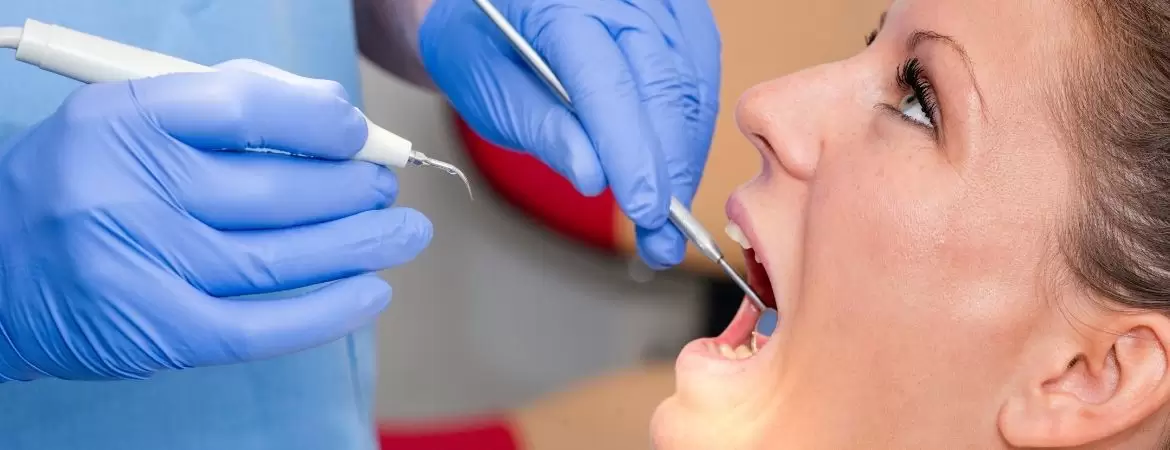
Tartar is the hardened form of dental plaque. In the absence of adequate oral hygiene, tartar can accumulate on your teeth, potentially causing gum disease and other oral health issues. It’s important to note that only going to a dental clinic can remove tartar; it cannot be eliminated through brushing and flossing alone.
Table of Contents
ToggleWhat is Dental Calculus (Tartar)?
Even with diligent at-home dental care, bacteria persist in your mouth. When these bacteria combine with proteins and food remnants, they create a sticky film known as dental plaque. This substance coats your teeth, infiltrates beneath the gum line, and adheres to dental work like fillings. Plaque harbors bacteria that can harm tooth enamel, resulting in cavities. Regularly removing plaque is crucial to prevent permanent tooth decay and gum disease.
However, if plaque is not consistently removed and it solidifies into tartar, also known as dental calculus, more significant issues arise. Tartar forms both below and above the gum line. Its rough and porous nature can lead to receding gums and gum disease. Special tools used in a dentist’s office are required to effectively remove tartar.
How Does Tartar Affect Teeth and Gums?
Dental calculus can impede effective brushing and flossing, making it more challenging to maintain proper oral hygiene. This difficulty may contribute to cavities and tooth decay.
The presence of tartar above your gum line poses risks, as the bacteria within it can irritate and harm your gums. Over time, this irritation may progress to more severe gum disease.
The initial stage of gum disease is called gingivitis, and it can often be halted and reversed through regular brushing, flossing, the use of an antiseptic mouthwash, and routine dental cleanings.
If you leave dental calculus untreated, gum disease can advance to periodontitis, where pockets form between the gums and teeth and become infected by bacteria. In response, your immune system releases chemicals that, when mixed with bacteria, can lead to damage in the bones and tissues supporting your teeth. Additionally, some studies suggest a connection between the bacteria in gum disease and other health problems, including heart disease.
Diagnosis of Dental Calculus
During a regular dental examination, a dentist can assess whether you have dental calculus. If they suspect the presence of cavities, gum disease, or other dental issues, they may also:
- Take dental X-rays to identify cavities or detect bone loss.
- Measure the depth of any pockets around your teeth to evaluate potential signs of gum disease.
How to Treat Dental Calculus?

The most effective way to treat tartar is by consulting a dentist or hygienist. They will safely remove the tartar using specialized instruments.
Attempting to remove tartar from your teeth without professional assistance can be tempting but may result in damage to your teeth, increasing susceptibility to cavities and other issues.
Based on the extent of tartar buildup, your dentist may recommend:
- Dental cleaning.
- Gum disease treatments.
1. Dental Cleaning
Regular dental cleanings are the optimal method for maintaining the health of your mouth and teeth. During a cleaning session, a dental hygienist employs specialized instruments to remove plaque and tartar from your teeth. Additionally, they meticulously floss between your teeth and polish the tooth surfaces using a rubber cup and gritty toothpaste.
For many individuals, cleanings every six months are sufficient to control tartar. However, if you are predisposed to cavities, gum disease, or other oral issues, more frequent cleanings may be necessary. Consult your dentist to determine the appropriate cleaning schedule for your specific needs.
2. Gum Disease Treatments
If dental calculus has led to noticeable bone loss around your teeth, your dentist may suggest gum disease treatment. These interventions aim to eliminate tartar situated beneath your gum line, areas inaccessible to brushing and flossing.
Common gum disease treatments include:
- Scaling and root planing.
- Osseous surgery .
- Laser periodontal therapy.
How Can You Prevent Tartar Buildup?
To prevent issues such as cavities and gum disease, it is crucial to proactively inhibit the formation of tartar. Here are some recommendations to help prevent tartar buildup on your teeth:
- Brush your teeth two to three times daily using a soft-bristled toothbrush and fluoride toothpaste. Ensure that oral health products bear the American Dental Association (ADA) Seal of Acceptance, indicating they have met stringent standards for safety and effectiveness.
- Floss between your teeth once daily, using traditional dental floss or interdental brushes. Seek product recommendations from your dentist or hygienist.
- Rinse with an alcohol-free, antibacterial mouthwash twice a day to eliminate oral bacteria responsible for plaque and tartar accumulation.
- Refrain from smoking and using tobacco products, as research indicates a higher risk of tartar development in individuals who smoke or chew tobacco.
- Schedule regular dental exams and cleanings. While at-home oral care is vital, professional dental examinations and cleanings are necessary. Many individuals benefit from preventive visits twice a year, but others may require more frequent appointments. Consult your dentist to determine the most suitable schedule for your needs.
Allowing tartar to accumulate on your teeth can result in the following consequences:
- Enamel Erosion: Tartar can contribute to the erosion of your enamel, the protective outer layer of your teeth.
- Cavity Formation: The presence of tartar increases the risk of developing cavities.
- Gum Swelling and Bleeding: Tartar buildup may cause your gums to swell and bleed, indicating potential gum health issues.
- Bad Breath: Tartar can contribute to bad breath, as it provides a conducive environment for the growth of bacteria.
- Teeth Discoloration: The accumulation of tartar on your teeth can lead to staining, affecting the appearance of your teeth.



